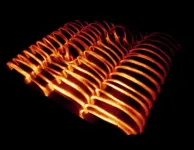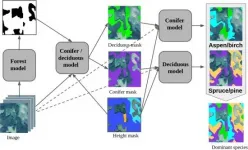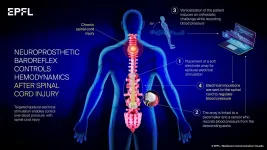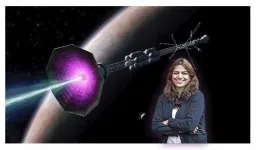(Press-News.org) A genetic engineering method makes it possible to observe how woody cell walls are built in plants. The new research in wood formation, conducted by the University of Copenhagen and others, opens up the possibility of developing sturdier construction materials and perhaps more climate efficient trees.
The ability of certain tree species to grow taller than 100 meters is due to complex biological engineering. Besides needing the right amounts of water and light to do so, this incredible ability is also a result of cell walls built sturdily enough to keep a tree both upright and able to withstand the tremendous pressure created as water is sucked up from its roots and into its leaves.
This ability is made possible by what are known as the secondary cell walls of plants. Secondary cell walls, also known as xylem or wood, are built according to a few distinct and refined patterns that allow wall strength to be maintained while still allowing connecting cells to transport water from one to the other.
How these wall patterns are built has been a bit of a mystery. Now, the mystery is starting to resolve. For the first time, it is possible to observe the process of woody cell wall pattern formation within a plant--and in real-time no less. A team of international researchers, including Professor Staffan Persson of the University of Copenhagen, has found a way to monitor this biological process live, under the microscope. The scientific article for the study is published in the renowned journal, Nature Communications.
This opens up the possibility of manipulating the building process and perhaps even making plant xylem stronger--a point that shall be returned to.
A genetic trick makes it possible to observe wood formation in real-time
Because wood forms in tissue that is buried deep inside the plant, and microscopes work best on the surfaces of objects, the wood-forming process is difficult to observe. To witness it in action, researchers needed to apply a genetic trick. By modifying the plants with a genetic switch, they were able to turn on wood formation in all cells of the plant--including those on the surface. This allowed them to observe the wood formation under a microscope in detail and in real time.
Cell walls consist mainly of cellulose, which is produced by enzymes located on the surface of all plant cells. Generally speaking, the process involves the orderly arrangement of protein tubes - known as microtubules - at the surface of the cells. The microtubules serve as tracks along which the wall producing enzymes deposit construction material to the wall.
"One can imagine the construction process as a train network, where the train would represent the cellulose-producing enzymes, as they move forward while producing cellulose fibers. The microtubules, or rails, steer the direction of the proteins, just like train rails. Interestingly, during the formation of woody cell walls these "rails" need to change their organization completely to make patterned walls - a process that we now can follow directly under our microscopes" explains Staffan Persson, of UCPH's Department of Plant and Environmental Sciences.
Taller trees and sturdier building materials
"We now have a better understanding of the mechanisms that cause the microtubules to rearrange and form the patterns. Furthermore, we can simulate the wall pattern formation on a computer. The next step is to identify ways that allows us to make changes to the system. For example, by changing patterns," suggests Persson.
First author, Dr Rene Schneider chimes in:
"Changing the patterns can alter the ways in which a plant grows or distributes water within it, which can then go on to influence a plant's height or biomass. For example, if you could create trees that grow differently by accumulating more biomass, it could potentially help slow the increase in carbon dioxide in the atmosphere."
In the longer term, Persson suggests that one of the most obvious applications is to manipulate biological processes to develop stronger or different woody construction materials.
"If we can change both the chemical composition of cell walls, which we and other researchers are already working on, and the patterns of cell walls, we can probably alter wood strength and porosity. Sturdier construction materials made of wood don't just benefit the construction industry, but the environment and climate as well. They have a smaller carbon footprint, a longer service life and can be used for manifold purposes. In some cases, they may even be able to replace energy-intensive materials like concrete," says Persson, whose background as a construction engineer compliments his plant biology background.
He also points to potential applications in the development of cellulose-based nanomaterials. These are gaining ground in medicine, where cellulose-based nanomaterials can be used to efficiently transport pharmaceuticals throughout the body.
However, these applications would first require further knowledge in how we can manipulate secondary walls and implementation of the knowledge in trees or other useful crop plants as much of our research is conducted in model plant organisms, such as thale cress, underscores both Staffan Persson and Rene Schneider.
FACTS:
The secondary cell walls of plants are located between the primary cell wall and the cell surface. They are typically formed when the thinner primary cell wall stops growing. In addition to cellulose, one of the main components of cell wall is lignin, which fills in the cavities in cellulose and thereby strengthens the wall even more.
Secondary cell walls have two major patterns in two distinct stages of cell life. The first is a spiral pattern which twists around the cell, making the walls stronger and allowing for the cells to continue to grow. The second pattern is perforated by numerous small holes. The latter pattern doesn't allow for cell growth. However, as cells connect with each via the holes, they are able to transport water from one cell to the next, and so on.
The scientific article for the study is published in the renowned journal, Nature Communications: https://www.nature.com/ncomms/
The study's first author is René Schneider, affiliated with the University of Melbourne in Australia and the Max Planck Institute for Molecular Plant Physiology in Germany. In addition to the University of Copenhagen's Staffan Persson, research was also conducted by researchers from Wageningen University, Netherlands; Nara Institute of Science and Technology, Japan; University of Tasmania, Australia and Shanghai Jiao Tong University in China.
Professor Staffan Persson was recruited from the University of Melbourne, Australia in July 2020 as a recipient of the Villum Investigator and NNF Laureate Research Grant. Persson is the new head of the Copenhagen Plant Science Center (CPSC) and a DNRF Chair at the Department of Plant and Environmental Sciences.
INFORMATION:
Skoltech scientists have developed an algorithm that can identify various tree species in satellite images. Their research was published in the IEEE Journal of Selected Topics in Applied Earth Observations and Remote Sensing.
Identifying tree species is essential for efficient forest management and monitoring. Satellite imagery is an easier and cheaper way to deal with this task than other approaches that require ground observations of vast and remote areas.
Researchers from the Skoltech Center for Computational and Data-Intensive Science and Engineering (CDISE) and Skoltech Space Center used a neural network to automate dominant tree species' identification in high and medium resolution images. A hierarchical classification model and additional data, such as vegetation height, helped ...
People with combined vision and hearing loss are nearly four times more likely to experience depression and more than three times more likely to suffer chronic anxiety, according to a new study published in the journal Frontiers in Psychology and led by Anglia Ruskin University (ARU).
Researchers analysed a health survey of 23,089 adults in Spain and found that while people suffering either vision or hearing loss both were more likely to report depression as those that were not, that risk increased to 3.85 times higher when respondents reported problems with both senses combined.
The study also found people with combined vision and hearing loss were 3.38 times more likely than the general population to report chronic anxiety.
It is understood to be the first study looking at ...
An international team of scientists headed by Grégoire Courtine at EPFL and CHUV and Aaron Phillips at the University of Calgary has developed a treatment that can dramatically improve the lives of patients with a spinal cord injury.
VIDEO: https://www.youtube.com/watch?v=UGXnuHgDWFU
"A serious and underrecognized result of these injuries is unstable blood pressure, which can have devastating consequences that reduce quality of life and are life threatening. Unfortunately, there are no effective therapies for unstable blood pressure after spinal cord injury". said Dr. Aaron Phillips, co-lead author of the study (see affiliations below). ...
Thursday, 28 January 2021: A study has found that adolescents who frequently use cannabis may experience a decline in Intelligence Quotient (IQ) over time. The findings of the research provide further insight into the harmful neurological and cognitive effects of frequent cannabis use on young people.
The paper, led by researchers at RCSI University of Medicine and Health Sciences, is published in Psychological Medicine.
The results revealed that there were declines of approximately 2 IQ points over time in those who use cannabis frequently compared to those who didn't use cannabis. Further analysis suggested that this decline in IQ points was primarily related to reduction in verbal IQ.
The research involved systematic review and statistical analysis on seven longitudinal studies ...
New insight into how human brains detect and perceive different types of touch, such as fluttery vibrations and steady pressures, has been revealed by UCL scientists with the help of the ancient Chinese cooking ingredient, Szechuan pepper.
Humans have many different types of receptor cells in the skin that allow us to perceive different types of touch. For more than a century, scientists have puzzled over whether touch signals from each type of receptor are processed independently by the brain, or whether these different signals interact before reaching conscious perception.
For the study, published in Proceedings of the Royal Society B, UCL researchers took a novel approach to this question by stimulating one type of touch receptor chemically, and another type mechanically. ...
Investors' moods are affected by gloomy weather. New research from Copenhagen Business School recommends entrepreneurs looking for finance should be aware of the weather forecast at the time they want to launch their crowdfunding campaigns.
The researchers wanted to explore whether weather-induced moods can explain crowdfunders' contributions and focused on the role of investors' moods and emotions including day-to-day decisions on the crowdfunding platform Companisto.
"Financial investment plays a vital role in the success of an entrepreneurial venture ...
Molecules consisting of many atoms are complex structures. The outer electrons are distributed among the different orbitals, and their shape and occupation determine the chemical behaviour and reactivity of the molecule. The configuration of these orbitals can be analysed experimentally. Synchrotron sources such as BESSY II provide a method for this purpose: Resonant inelastic X-ray scattering (RIXS). However, to obtain information about the orbitals from experimental data, quantum chemical simulations are necessary. Typical computing times for larger molecules take weeks, even on high-performance computers.
Speeding up the evaluation
"Up to now, these calculations have mostly been carried out subsequent to the measurements", explains theoretical chemist Dr. Vinicius Vaz da Cruz, ...
Researchers at Lund University in Sweden believe they have identified a gene variant that can cause cerebral small vessel disease and stroke. The study is published in Neurology Genetics.
"The patients we have studied are from the same extended family, and several of them have been diagnosed with cerebral small vessel disease and suffered strokes. After tissue examination and using genetic sequencing methods, we found that they were carriers of a new gene variant that could be connected to their diagnoses," says Andreea Ilinca, researcher at Lund University ...
Recent events such as the Covid-19 pandemic, locust infestations, drought and labour shortages have disrupted food supply chains, endangering food security in the process. A recent study published in Nature Food shows that trade restrictions and stockpiling of supplies by a few key countries could create global food price spikes and severe local food shortages during times of threat.
'We quantified the potential effects of these co-occurring global and local shocks globally with their impacts on food security,' explains Aalto University Associate Professor Matti Kummu. The results of this research have critical ...
A new type of rocket thruster that could take humankind to Mars and beyond has been proposed by a physicist at the U.S. Department of Energy's (DOE) Princeton Plasma Physics Laboratory (PPPL).
The device would apply magnetic fields to cause particles of plasma, electrically charged gas also known as the fourth state of matter, to shoot out the back of a rocket and, because of the conservation of momentum, propel the craft forward. Current space-proven plasma thrusters use electric fields to propel the particles.
The new concept would accelerate the particles using magnetic reconnection, a process found throughout the universe, including the surface of the sun, in which magnetic ...





